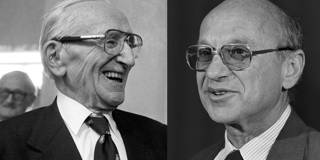The progenitors of neoliberalism were novel thinkers who engaged in scholarly pursuits while also seeking to instrumentalize their concepts in the real world. All wrestled with a question that came to dominate much of the twentieth century: Does freedom lead to prosperity, or is it the other way around?
CAMBRIDGE – Milton Friedman was not given to self-doubt. His commitment to the virtues of unobstructed markets made him the guru of deregulation, privatization, and free trade. In his view, unfettered capitalism is the bedrock of civic and political freedom, whereas societies that inhibit the workings of supply and demand are condemned to lose it. These beliefs undergirded the hyper-globalization that prevailed for half a century from the 1970s, and Friedman was their avatar.
Yet, late in life, Friedman did occasionally express doubts. Around the time China joined the World Trade Organization in 2001, he worried that his table-thumping “privatize, privatize, privatize!” mantra was a mistake. “I was wrong. That wasn’t enough,” he told an audience of perplexed conservatives. After all, Hong Kong and Singapore, once touted as mighty little engines of globalization, had become examples of market-oriented models yielding less freedom: property was sacred, but elections were not.
Friedman, the high priest of neoliberalism, eventually watched as his legacy gave way to political monetarism, soaring public debt, and, lately, the return of the regulatory state. To tell the story of his life, and the influence he brought to bear on the modern world – as Stanford historian Jennifer Burns does in a marvelous new biography, Milton Friedman: The Last Conservative – is to track the arc of our shifting attitudes toward markets and modernity more broadly.

CAMBRIDGE – Milton Friedman was not given to self-doubt. His commitment to the virtues of unobstructed markets made him the guru of deregulation, privatization, and free trade. In his view, unfettered capitalism is the bedrock of civic and political freedom, whereas societies that inhibit the workings of supply and demand are condemned to lose it. These beliefs undergirded the hyper-globalization that prevailed for half a century from the 1970s, and Friedman was their avatar.
Yet, late in life, Friedman did occasionally express doubts. Around the time China joined the World Trade Organization in 2001, he worried that his table-thumping “privatize, privatize, privatize!” mantra was a mistake. “I was wrong. That wasn’t enough,” he told an audience of perplexed conservatives. After all, Hong Kong and Singapore, once touted as mighty little engines of globalization, had become examples of market-oriented models yielding less freedom: property was sacred, but elections were not.
Friedman, the high priest of neoliberalism, eventually watched as his legacy gave way to political monetarism, soaring public debt, and, lately, the return of the regulatory state. To tell the story of his life, and the influence he brought to bear on the modern world – as Stanford historian Jennifer Burns does in a marvelous new biography, Milton Friedman: The Last Conservative – is to track the arc of our shifting attitudes toward markets and modernity more broadly.